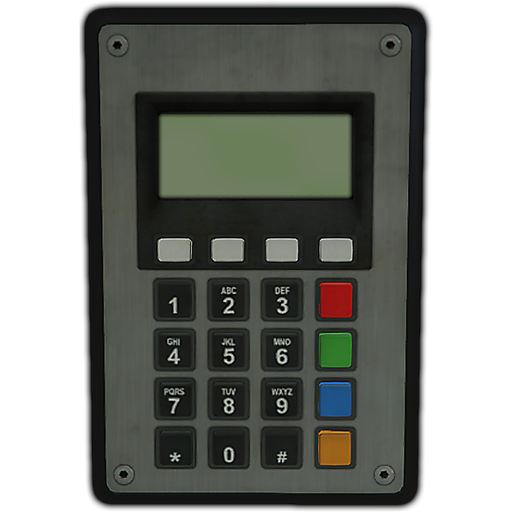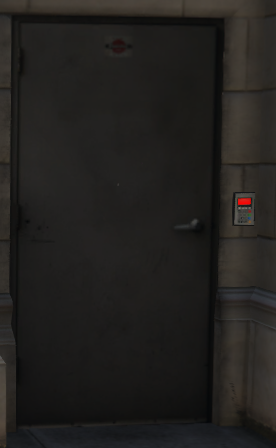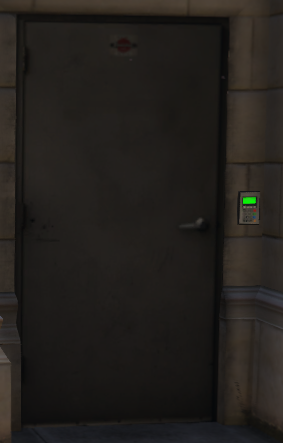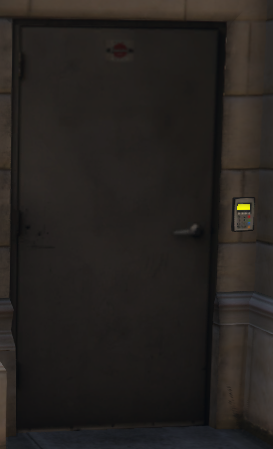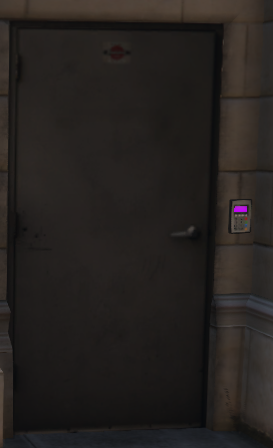demmylock is a door locking resource for FiveM, and is entirely useless without a cfx-server running and a FiveM client connected to that server.
This documentation assumes you know the basics of editing .lua files. The syntax of such files is not explained here, but you might be able to guess what to do based on the examples. Your server will not explode from you experimenting a little, but you do run the risk of breaking the locks, meaning all locked doors stay frozen in place and all unlocked doors are open to everyone. It is highly recommended to play around with this on your test server before actually using it in production.
It is also assumed that you are familiar with the vector3 data type.
Absolutely no support what so ever is given for this resource. If you have an issue with it you are invited to create an issue here on GitHub, but there are absolutely no guarantees that I will do anything about it. "How do I..." issues may be closed without comment.
Feel free to submit pull requests (including against the documentation!) if you have anything to contrubute. Feature requests without provided use cases and/or code will be ignored, though.
All definitions, file formats and procedures are subject to change without notice. This documentation is without any guarantees of accuracy, and the package as a whole comes with no warranty, and is not to be considered fit for any perticular purpose. See the license for the legaleese version of this babble.
demmylock was created from an idea that all the different door lock scripts are all very dependant on their frameworks, and are generally very aesthetically displeasing.
What I set out to do here, was to make it ever so slightly prettier, by not depending on floating 3D text, and to make it completely independant from any framework.
In demmylock it doesn't matter what "job" you have. This script has no idea.
It cares about one thing, and one thing only: Do you know the code?
To visualize the lock, two components are used.
- The prop
prop_ld_keypad_01 - A tiny marker number 42 (the square one)
The marker is overlayed over the prop to show the state of the lock. More on that in the Lock states section. When you approach the lock, you get a so-called helptext in the upper left corner, and if you press the right button you will be shown a keypad. The keypad graphics are based on a screenshot of the prop used.
Also, performance. After a bit of tinkering I'm confident that demmylock outperforms all other publically released general-purpose door locking resource. If it doesn't, please point this out to me, and I'll head over to it to get schooled.
The numbers, as well as * and #, can be entered as part of the code.
| Button | What it does |
|---|---|
| 0-9, # and * | Enter as part of the code |
| Red | Use the entered code to lock the door |
| Green | Use the entered code to unlock the door |
| Blue | Erase the last digit entered |
| Yellow | Clear keypad entry entirely |
| Silver | Does exactly nothing |
When a code is entered, it is stored on the client as the code for that door. That means you don't have to enter the code again the next time you use that door, and a different prompt is shown for the helptext. This is useful for everyone, but especially for streamers. It means you only have to hide the code the first time you enter it, and then you can re-use that code for as long as it's valid.
If the server responds with "Na-ah, that's the wrong code!", that code is forgotten for ever, and you will have to enter a new code the next time you want to open that lock.
The locks have four states. These are:
| Color | State | Meaning |
|---|---|---|
| Red | Locked | Nobody can walk through. |
| Green | Unlocked | Open for anyone. |
| Yellow | Will relock | Open for anyone, but will lock automatically soon. |
| Purple | Teleport | Anyone can step through, but only for a few seconds. |
The lock states look like this:
Yes, I am aware that the red and green are the exact same hue, and might be hard to distinguish if you are red/green color blind. Fixing this is on my list, but I need an actual color blind person to help me out in testing it.
In the configuration file, you can mess around with a few settings.
| Setting | What it changes |
|---|---|
| keypad | What prop is used for the keypad object. |
| indicator | What marker is used to show the state of the lock. |
| teleportTime | How many milliseconds a door stays open for teleportation. |
| doorSpeed | How quickly a propped-open door swings closed when it is locked. |
| fadeTime | The number of milliseconds it takes for the screen to fade in or out when teleporting. |
| range.areaMargin | How far outside a grouping of locks you can be before they pop up. |
| range.interact | How far you can be from a keypad and still interact with it. |
| range.doorLoad | How far from a door does it get loaded into the Door System |
| range.vehicleSensor | The range of a vehicle sensor, if nothing is specified. |
The actual lock definition is really fiddly. I mean, surprisingly fiddly and complicated.
I highly recommend using some kind of tool to aid you in this. Personally, I make my own tools, so for this I use DemmyCam to do this. I've built "modes" into it that greatly simplifies this work.
Lock definition is done in the locks directory.
To define new locks, you create a new file in the locks directory and populate it with one or more AddLocks statements.
AddLocks('Area name',{
['Lock name'] = {
-- Lock specification goes here
},
})The area name is never shown to the user, but it's very important when looking up if the code is correct! More on the codes in the Defining codes section.
A simple lock is a lock that has a keypad on the wall and a single regular swinging door.
AddLocks('Example',{
['Simple lock'] = {
locked = true,
doors = {
{model=854291622,coords=vector3(346.774, -584.002, 43.434)},
},
keypads = {
{coords=vector3(348.214, -584.642, 43.650),rot=vector3(0.000, -0.000, -20.000)},
},
},
})The locked bit is simply the state you want the lock to be in when the resource starts.
High security stuff (jail cells, for example), gets a true here, while stuff you might want to lock sometimes gets a false. You can also omit this entirely, and false will be assumed.
The doors bit is a list of doors. A door has three properties.
| Propery | Type | What it means |
|---|---|---|
| model | Integer | The hash of the model name of the door. |
| coords | vector3 | The coordinates of the door. |
| keeploaded | Boolean | See the Gates behave strangely section |
Using this information, demmylock can determine exactly what door you mean, and freeze it when it's locked. Note that it's possible to specify several doors per lock, meaning you operate both doors in a double-door together, if you want.
While demmylock makes no effort to stop you from putting the same door under multiple locks, it is not recommended that you do so. It can lead to undesired effects unless you do it very carefully.
The keypads bit is telling demmylock where you want the keypads that lock and unlock this lock. The example shows a static keypad, which means it doesn't move at all. Static keypads have two properties.
| Property | Type | What it means |
|---|---|---|
| coords | vector3 | The exact location to place the keypad. |
| rot | vector3 | The exact rotation you want the keypad to have, in rotation order 2. |
demmylock will figure out where to put the state indicator on it's own, based on this information. Note that as with doors, you can place multiple keypads. Typically you want one on each side of the door, but if you want 73 keypads, demmylock will let you squander all the resources you want.
A slightly more complicated concept is to place the keypad on the door itself rather than have it stuck to the wall next to it. This looks kinda nice, and is very handy for situations where the walls are difficult to attach to, such as the cell walls in the Mission row lockup.
These keypads move with the door, so I call them dynamic keypads.
Again, I want to stress that this is very fiddly to do manually, and you probably want DemmyCam to help you out. Seriously, this is fiddly enough to manually adjust after placing with demmycam, so doing it without is just going to frustrate you.
AddLocks('Example', {
['Keypad-on-door lock'] = {
locked = true,
doors = {
{model=854291622,coords=vector3(346.774, -584.002, 43.434)},
},
keypads = {
{door=1,offset=vector3(-1.172, -0.042, -0.127),rot=vector3(0,0,0)},
},
},
})Here we use the exact same doors section, so see above for that part. What has changed is how keypads is defined.
| Property | Type | What it means |
|---|---|---|
| door | Integer | This is a reference to a door. In this case, the first door in the doors section. This specifies which door to attach the keypad to. If you have multiple doors, you can attach to whichever one you want. |
| offset | vector3 | The offset, relative to the center of the door model (including the invisible parts), at which the keypad is attached. |
| rot | vector3 | The rotation, in rotation order 2, that is applied to the keypad, relative to the door it's attached to. |
In this example, there is only one keypad, but typically you want one on either side of the door. While you can probably interact with a single keypad from both sides of the door, you lose the nice indicator if you have just the one. Note that it is not a problem at all to combine static and dynamic keypads for the same lock.
Sometimes it's so important that a door is locked that you don't want to risk forgetting to lock it. That's why automatic relocking is supported. Simply add a relock = 5000 to the lock specification, and it will lock again after 5000 milliseconds.
AddLocks('Example', {
['Simple lock'] = {
locked = true,
relock = 5000,
doors = {
{model=854291622,coords=vector3(346.774, -584.002, 43.434)},
},
keypads = {
{coords=vector3(348.214, -584.642, 43.650),rot=vector3(0.000, -0.000, -20.000)},
},
},
})Of course, that number can be anything you want. It is not possible to lock the door prematurely, so very long relock times are not recommended.
Sometimes it's not enough to just have the door be unlocked. You want it to be actually propped open! To do this, simply add the openness ration you want it at. This ranges from -1.0 to 1.0, which are completely open in different directions.
AddLocks('Example',{
['Simple lock'] = {
locked = true,
relock = 5000,
doors = {
{model=854291622,coords=vector3(346.774, -584.002, 43.434),open=1.0},
},
keypads = {
{coords=vector3(348.214, -584.642, 43.650),rot=vector3(0.0, 0.0, -20.0)},
},
},
})Note that almost every time, a double door set will be opposite of eachother if you want them to open the same way. One at -1.0 and the other at 1.0.
Some gates, specifically the ones that are set to react to an approaching vehicle at pretty dramatic distances, do not play well with the loading and unloading of doors that demmylock does. When such a gate is behaving stragely, you have to tell demmylock to just keep it loaded rather than unloading it to make room for more doors.
This is done by adding keeploaded=true to the door definition, like so:
AddLocks('Bennys',{
['Gate'] = {
locked = true,
doors = {
{
model=-427498890,
coords=vector3(-205.683, -1310.683, 30.296),
keeploaded=true,
},
},
keypads = {
{coords=vector3(-207.779,-1310.102,31.59),rot=vector3(0,0,90)},
{coords=vector3(-207.929,-1310.911,31.59),rot=vector3(0,0,0)},
},
},
})And yes, I picked the Benny's gate because it is an excellent example of this problem.
A type of lock that has no doors at all! It's just a keypad on a wall, though it's probably best for immersion that it's placed next to what looks like a door. There are a million of these around the map. For example, the door I used in my indicator demonstration is not actually a door, it is a wall that is textured to look like a door.
The whole idea behind teleporting locks is to attach a door in one section of the map to a different section. For example, the Maze Bank office tower has a bunch of office locations inside it, but no way to get to them without teleporting.
This is also why it's possible to set a teleporting lock with multiple destinations! First, though, let's look at a basic teleporter.
AddLocks('Example',
['Server farm'] = {
locked = true,
teleport = {
{
coords=vector3(2154.875,2921.012,-81.076),
heading=-90.0,
ipl='xm_x17dlc_int_placement_interior_5_x17dlc_int_facility2_milo_',
},
},
keypads = {
{coords=vector3(107.7,-1090.454,29.830),rot=vector3(0,0,160)},
},
},
})Note: There is no doors section when there is a teleport section! The two will conflict.
Let's have a look at the teleport section:
| Property | Type | What it means |
|---|---|---|
| coords | vector3 | The teleport destination in world coordinates. |
| heading | Float | The heading you want the player to face when they get to the other side. |
| ipl | String | Optional interior to load before teleporting. |
Because teleporters are most often used to go to interior locations, and we don't want users to fall through the void, you can specify an optional interior to load before moving the player.
Note: If the specified ipl is invalid, it'll be stuck loading for ever, breaking demmylock for whomever tries to teleport, so be sure to test this properly!
demmylock makes no attempt at loading interior props or setting interior colors or anything of the sort when teleporting. This is not a "MILO manager" resource at all, and will only do the most rudementary of checks. If the teleporter leads to somewhere that is loaded automatically, you can just omit the ipl here.
After entering the correct code, anyone can step through the teleporter by just strolling up to the keypad and pressing E. This is intentional, as it enables you to bring people with you through the teleporter withot telling them the code, just like when you unlock a regular door.
You can specify multiple teleport destinations, and what code is used will determine which is used. You can also use locked = false to make a teleporter always be active, but then you will also need to specify what destination to use as it can't use a code to figure that out. Let's use our server room example again, but this time with an always-open exit teleporter.
AddLocks('Example', {
['Server farm'] = {
locked = true,
teleport = {
{
coords=vector3(2154.875,2921.012,-81.076),
heading=-90.0,
ipl='xm_x17dlc_int_placement_interior_5_x17dlc_int_facility2_milo_',
},
},
keypads = {
{coords=vector3(107.7, -1090.454, 29.830),rot=vector3(0.008, -0.048, 160.019)},
},
},
})
AddLocks('Inside server farm', {
['Use elevator'] = {
locked = false,
destination = 1,
teleport = {
{coords=vector3(109.465, -1090.326, 29.302),heading=20.0},
},
keypads = {
{coords=vector3(2156.355, 2922.228, -80.610),rot=vector3(0.000, 0.000, 31.961)},
},
},
})
IMPORTANT NOTE: It might be tempting to put both the teleporter and the return teleporter in the same area. That is to say, put the return teleporter in the Example area here. Don't do this. It will create an absurdly large area to include both places, and that will cost a lot more resources than is needed to waste. This is absolutely fine for short hops (such as through a door that naturally leads to the other side of the same wall), but for very long teleports this makes the area very large, and potentially always active.
In this example, we see that the return teleporter, Use elevator, is not locked, and has destination = 1. This means it will use the first teleport destination every time and anyone can step through it without ever being asked for a code. Very useful for exits!
Teleporters always close automatically after the time specified in the configuration.
Code locks are entirely useless if there are no codes. If you don't specify any codes, then any code entered is, by definition, wrong. The codes are in a separate directory called codes/. Because the entire locks/ directory is transmitted to the client, it's silly to have the codes in there. A techsavvy user would have no trouble at all just opening the resource up and reading the codes. The way this is organized, the codes never leave the server.
Assuming you have a lock file that looks like this...
AddLocks('Example', {
['Simple lock'] = {
locked = true,
doors = {
{model=854291622,coords=vector3(346.774, -584.002, 43.434),heading=340.204},
},
keypads = {
{coords=vector3(348.214, -584.642, 43.650),rot=vector3(0.000, -0.000, -20.000)},
},
},
})...you want a code file that matches, like so...
AddCodes('Example', {
['Simple lock'] = '1234',
})Now anyone can unlock that door by using the code 1234 because Example matches the lock's area and Simple lock matches the lock's name.
After changing locks or codes, you have to restart the resource. This will reset all locks to their default state, so you might want to warn your users if you have to do this while the server is up and running normally.
Imagine you have a building with lots of doors in it, and you want them all to have the same code. Then imagine this code leaks out, and you need to change them all. This is very tedious, which is why there is such a thing as a _default code. This code applies to all doors that are not otherwise specified in that area, except teleporters.
AddCodes('Example', {
['Simple lock'] = '1234',
['Another lock'] = '1234',
['Yet another lock'] = '1234',
['How many locks are there?'] = '1234',
['Too damn many'] = '1234',
['This one is special'] = '2468',
})...becomes...
AddCodes('Example', {
_default = '1234',
'This one is special' = '2468',
})When you use the same code for a bunch of doors, the client has no idea. As mentioned, the code files are never sent to the client. This means the user has to enter a different code for all the doors, even though the use the same code on the server side.
You can tell the client to re-use any correct code for a lock in a group on other locks in the same group by specifying that is is a groupcode lock.
AddLocks('Example', {
['This lock'] = {
locked = true,
groupcode = true,
doors = {
-- You know the drill
},
keypads = {
-- Whatever
},
},
['That lock'] = {
locked = true,
groupcode = true, -- Same code saved
doors = {
-- Different doors
},
keypads = {
-- Different keypads
},
},
})Teleporter codes, even when there is just one destination, are different from regular codes.
Let's assume this teleporter exists:
AddLocks('Example', {
['Server farm'] = {
locked = true,
teleport = {
{coords=vector3(2154.875,2921.012,-81.076),heading=-90.0},
{coords=vector3(0,0,0),heading=0.0}, -- under the map :O
},
keypads = {
{coords=vector3(107.7, -1090.454, 29.830),rot=vector3(0,0,160)},
},
},
}...then the code looks like this...
AddCodes('Example',{
['Server farm'] = {'1234', '2468'},
})See those curly brackets? They indicate that it's a teleporter code set. If you walk up to that teleporter and use the code 1234, which is the first code, then you will go to the first teleporter destination. If you use the code 2468, which is the second code, you will go to the second teleporter destination.
Only very few locks make sense as an entity set lock. I currently know of only one: The rear gate at Simeon's car dealership.
AddLocks('Simeon', {
['Back gate'] = {
locked = true,
entitySets = {
interior = vector3(-29.936, -1088.536, 26.422),
open = {'shutter_open'},
locked = {'shutter_closed'},
},
keypads = {
{coords=vector3(-32.108, -1085.724, 26.876),rot=vector3(0.000, -0.000, -20.242)},
{coords=vector3(-31.729, -1085.350, 26.876),rot=vector3(0.028, -0.020, 69.972)},
},
},
})| Property | Type | What it means |
|---|---|---|
| interior | vector3 | Where to sample the interior ID for what interior the entity sets are to be enabled and disabled in. |
| open | table | This is a table of strings (just one in the example, but still!) that holds all the items to be enabled when the lock is open. |
| locked | table | This is a table of strings that holds all the items to be enabled when the lock is locked. |
Note that all entity sets must be in the same interior.
Also note that any items in the open list will be disabled when the lock is locked, and any items in the locked list will be disabled when the lock is open. If either is omitted, this still leaves a useful switch for whatever interior entity set you might want to toggle.
Sometimes you want a gate to open automagically when you approach it by car. This saves you from getting out and walking over to the keypad, poking in the key and then going back to your car.
This works absolutely best combiled with automatic relocking, as the sensors only open the gate, they don't close it again.
Note that the lock will only open if you have previously unlocked that lock (or, if it has a group code, a lock in that group). The first time you use it, you still have to actually input they code at the keypad.
Let's have a look at an example:
AddLocks('Sensor demo',{
['Gate'] = {
locked = true,
relock = 10000,
doors = {
{model=546378757,coords=vector3(-137.799, 973.709, 236.114),open=-1.0,keeploaded=true},
{model=-1249591818,coords=vector3(-132.789, 971.500, 236.114),open=1.0,keeploaded=true},
},
keypads = {
{coords=vector3(-132.547, 971.055, 236.0),rot=vector3(0.0, 0.0, -24.388)},
{coords=vector3(-132.272, 971.607, 236.0),rot=vector3(0.0, 0.0, 164.217)},
},
vehicleSensors = {
{coords=vector3(-136.500, 969.140, 234.880)},
{coords=vector3(-133.575, 976.755, 234.879)},
},
},
})| Property | Type | What it means |
|---|---|---|
| coords | vector3 | The sensor's location. |
| range | Float | Entirely optional range of the sensor. |
Note that if you do not specify a range, the one given in the configuration. As with keypads, it makes sense to have one on each side of the gate.
I probably forgot at least three important points, so feel free to let me know what they are.
